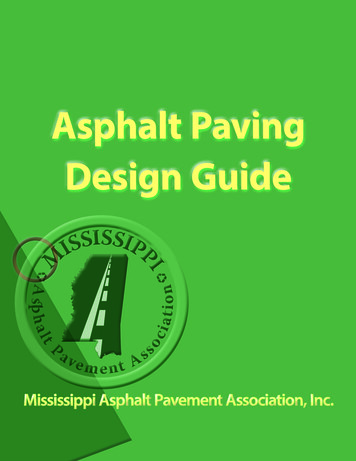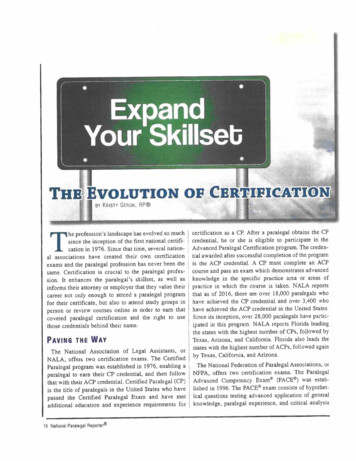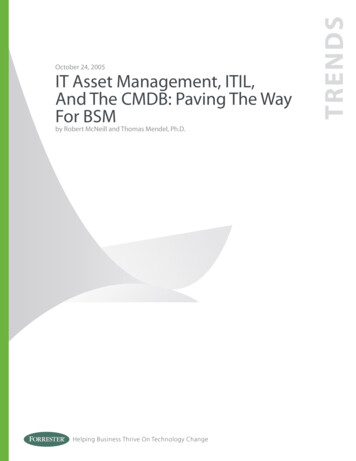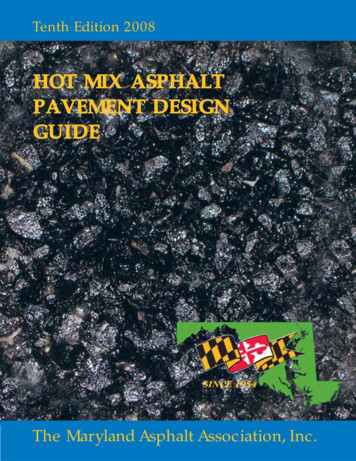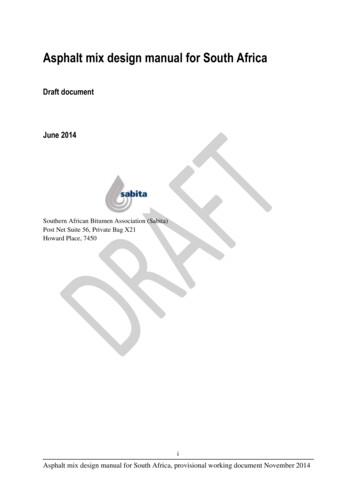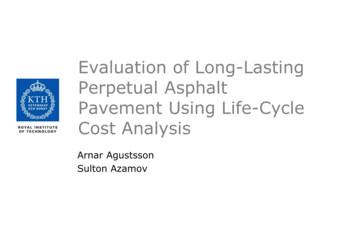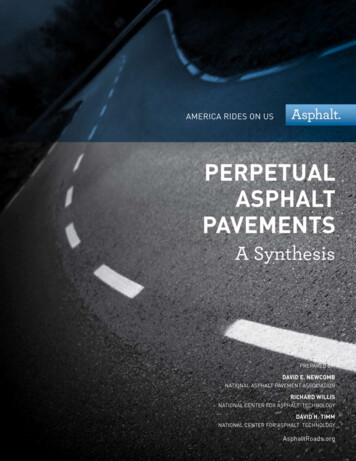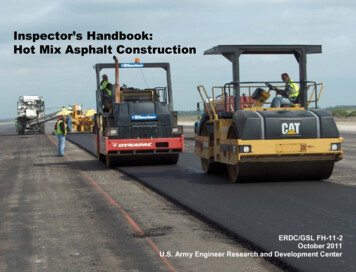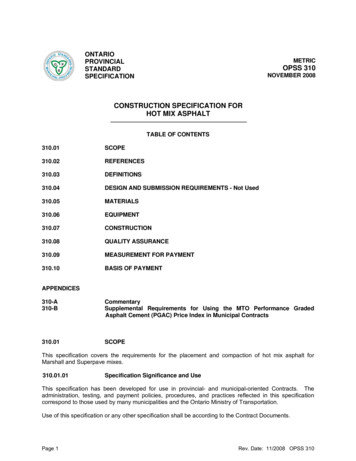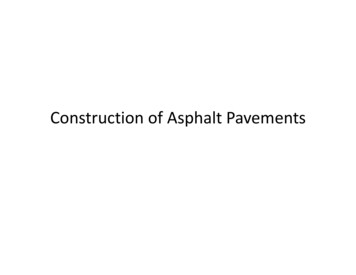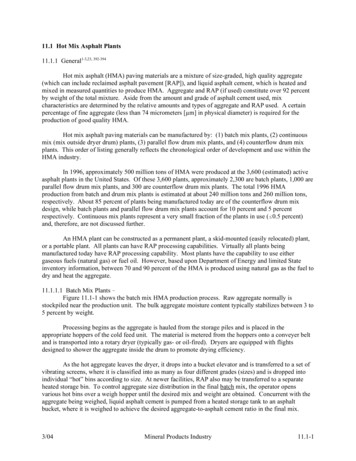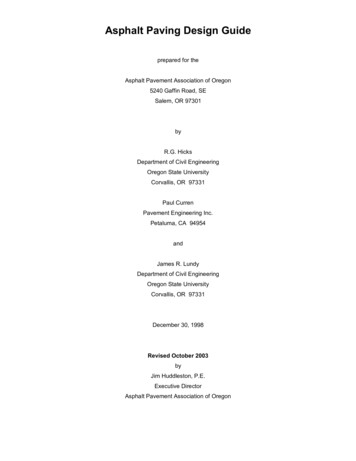
Transcription
Asphalt Paving Design Guideprepared for theAsphalt Pavement Association of Oregon5240 Gaffin Road, SESalem, OR 97301byR.G. HicksDepartment of Civil EngineeringOregon State UniversityCorvallis, OR 97331Paul CurrenPavement Engineering Inc.Petaluma, CA 94954andJames R. LundyDepartment of Civil EngineeringOregon State UniversityCorvallis, OR 97331December 30, 1998Revised October 2003byJim Huddleston, P.E.Executive DirectorAsphalt Pavement Association of Oregon
COPYRIGHT NOTICEPublications produced and published by the Asphalt Pavement Association of Oregon (APAO) are copyrighted by the Associationand may not be republished or copied (including mechanical reproductions) without written consent. To obtain this consent, contact the Association at the address given in this publication.2003 Asphalt Pavement Association of Oregon
PREFACEAPAO Design GuideThis guide is published by the Asphalt Pavement Association of Oregon (APAO) for the use and benefit of designers.It covers a number of applications, including streets and driveways, commercial and industrial facilities and specialtyapplications such as bikeways, cart paths, tennis courts and tracks. Recent additions include chapters on Life CycleCost, Intersection Design, and Porous Pavements for Commercial Facilities.The manual contains the necessary information to allow the user to do the following:1) Select and specify the correct asphalt concrete mix for a given application.2) Select and specify the most appropriate asphalt binder for the application and climate.3) Select and specify the most appropriate mix design method and criteria for the application.4) Select the appropriate structural design inputs and perform a structural design.5) Select the appropriate construction specification for the application.6) Understand the importance of planning for pavement maintenance, the various maintenance techniques available, and the optimum timing for the maintenance treatments.The procedures and guidelines provided in this manual are consistent wherever possible with those provided in theOregon Standard Specifications for Construction. The Oregon Standard Specifications for Construction is the result ofa joint effort by the American Public Works Association (APWA), the Oregon Department of Transportation (ODOT)and the construction industry. Its purpose is to provide more uniform and consistent specifications and standards forall public works projects in Oregon. This design guide is consistent with the standard specification and covers the applications not included in the Oregon Standard Specifications for Construction.Use of this manual will result in improved asphalt pavement quality and performance throughout the state of Oregon.The Asphalt Pavement Association of Oregon (APAO)The Asphalt Pavement Association of Oregon is a non-profit trade association representing contractors and associatedfirms. APAO was formed in 1969 by a small group of asphalt paving contractors to develop improved specificationsand products. The Association and its members are dedicated to promoting asphalt pavements by developing programs to enhance quality and excellence in all aspects of asphalt technology.The Association is actively involved in providing state of the practice training and education for members and customers and to develop manuals such as this one to improve the quality of asphalt pavements throughout the state.
TABLE OF CONTENTSPagePreface .iTable of Contents .iiAcknowledgments .viiiList of Figures .ixList of Tables .xi1.0 INTRODUCTION .1-11.1 Desirable Characteristics of Pavements .1-11.2 Attributes of Asphalt Pavements .1-11.3 Organization of Guide .1-21.4 Limitations and Use of Manual .1-21.5 References .1-32.0 CONSIDERATIONS FOR MATERIALS, MIX SELECTION AND MIX DESIGN .2-12.1 Asphalt Binders .2-1Desirable Asphalt PropertiesTesting of Asphalt PropertiesClassification of Asphalt BindersSelecting Correct PG GradeRecommended PG Grades for OregonReliability ConsiderationsWorkability and Other ConsiderationsGrade BumpingSpecifying Elastomer Modified (ER) BinderImpact of Recycled Asphalt Pavement (RAP) on Binder Grade Selection2.2 Aggregates .2-7Types of aggregateDesirable aggregate properties2.3 Asphalt Mix Types .2-82.4 Selecting Mix Type.2-9Basic considerationsGuidelines
2.5 Mix Design Procedures .2-10Superpave methodLaboratory vs. field compactionSummary2.6 What to Look for in a Mix Design .2-13Summary2.7 References .2-143.0 PAVEMENT DESIGN CONSIDERATIONS .3-13.1 Design Overview .3-1LimitationsDesign backgroundAASHTO ProcedureMechanistic/Empirical Procedures3.2 Design Inputs .3-4Truck trafficSoil supportSubgrade classesSoil classificationsSubgrade strength/modulus testsAdditional soil considerationReliabilityDesign approachFull depth asphalt pavements3.3 Stage Construction .3-15Advantages of stage constructionDisadvantages of stage constructionProcedureExample designSummary3.4 Other Considerations .3-16DrainageSurface drainageSubsurface drainageFrost actionConstruction considerationsPavement management systemsSummary3.4 References .3-19
4.0 SUBGRADE TREATMENT.4-14.1 Stabilization .4-1Lime-modified soilCement-modified soilEmulsion-modified soil4.2 Moisture – Density and Water Control .4-2Moisture – Density ControlWater Content Control4.3 Cut and Cover .4-34.4 Geotextiles .4-3Material propertiesSelecting geotextilesCost considerationsGeotextile testingSpecificationsField inspection checklist4.5 References.4-55.0 URBAN STREETS, RURAL ROADS, DRIVEWAYS AND PARKING LOTS .5-15.1 Local Residential Streets .5-1Design considerationsTraffic analysisSoil supportMix selectionThickness recommendationsDrainage provisionsConstruction guidelines5.2 Collector and Arterial Streets .5-2Design considerationsTraffic analysisSoil supportMix selectionThickness recommendationsDrainage provisionsConstruction guidelines5.3 Secondary and Rural Roads .Design considerationsMix type selectionThickness recommendationsDrainage provisionsConstruction guidelines5-4
5.4 Driveways and Private Roadways .5-4Design considerationsMix type selectionThickness recommendationsDrainage provisionsConstruction guidelines5.5 Light Commercial Parking Lots .5-5Design considerationsMix selectionThickness recommendationsDrainage provisionsConstruction guidelines5.6 Heavy Commercial Parking Lots .5-6Design considerationsMix selectionThickness recommendationsDrainage provisionsConstruction guidelines5.7 Industrial Areas .5-75.8 Construction Practices for Asphalt Pavements – Streets, Driveways and Parking Lots .5-7Streets, driveways and parking lotsExisting driveways5.9 References .Design Example – City Street Design Example – Parking Lot . .5-95-105-126.0 SPECIALTY PAVEMENTS .6-16.1 Bikeways, Paths, Trails and Walkways .6-1Design considerationsThickness recommendationsMix selectionDrainage provisionsConstruction guidelines6.2 Playgrounds/Recreational Areas .Design considerationsThickness recommendationsDrainage provisionsConstruction guidelines6-3
6.3 Tennis Courts .6-4Design considerationsThickness recommendationsMix recommendationsDrainage and slope provisionsConstruction guidelines6.4 Running Tracks .6-5Design considerationsThickness recommendationsMix recommendationsDrainage provisionsConstruction guidelines6.5 Special Environmental Uses .6-66.6 References .6-77.0 DESIGN OF POROUS PAVEMENTS FOR COMMERCIAL FACILITIES .7-17.1 Introduction .7-17.2 Background .7-17.3 Installations Old and New .7-27.4 How It Works .7-27.5 Design Considerations .7-37.6 Soil and Subsurface Conditions .7-47.7 When Infiltration is Limited .7-57.8 Water Quality .7-67.9 Construction .7-77.10 Maintenance .7-77.11 Deicing and Freezing Issues .
Asphalt Paving Design Guide prepared for the Asphalt Pavement Association of Oregon 5240 Gaffin Road, SE Salem, OR 97301 by R.G. Hicks Department of Civil Engineering Oregon State University Corvallis, OR 97331 Paul Curren Pavement Engineering Inc. Petaluma, CA 94954 and James R. Lundy Department of Civil Engineering Oregon State University Corvallis, OR 97331 December 30, 1998
